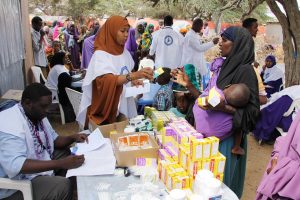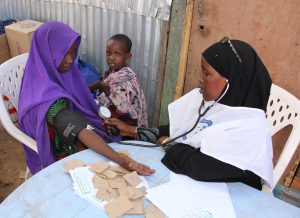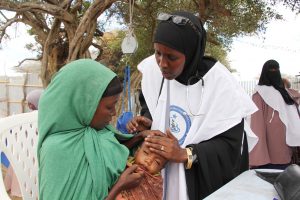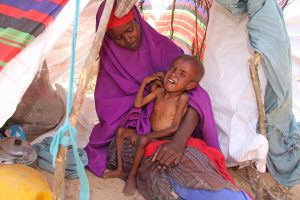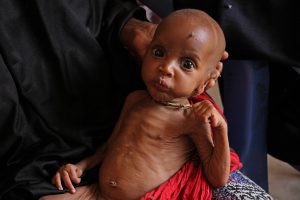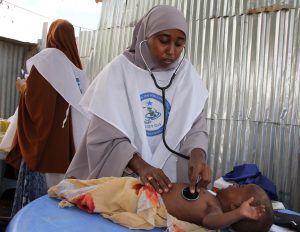
Most parts of Somalia are facing serious drought conditions with the larger part of the population facing severe to extreme drought conditions. Since the last half of 2016, the severity has been spreading spatially and the impacts getting worse with time. Some climate models are already predicting a poor rainy season in the coming season, which may further aggravate the existing drought conditions. However, this forecast will be confirmed in the coming month during a regional Climate Outlook Forum.
The months of January and February usually experience the lowest amounts of river flow along the Shabelle River. January 2017 has however seen significantly below normal levels along the river since the beginning of the month. Some parts of the river in the lower reaches have dried up. This has been caused by below normal rains experienced in the upper parts of the Shabelle basin during the previous season which in turn has led to reduced river flow and over utilization of the river water for various uses both in Ethiopia and inside Somalia.
River levels along the Shabelle River in Ethiopia are also currently below normal. Water levels have decreased significantly in the Melka Wakena Hydroelectric Power Station in Ethiopia located in the upper part of the Shabelle river. There are reported cases of water diversion from the river for irrigation purposes in Gode and Khellafo areas (some 50 kilometers from the Somali border). With no rains expected in the coming week, the situation is likely to deteriorate further with reduction of the river flow inside Somalia.
The low flows along the Shabelle River both in Somalia and Ethiopia are due to a hydrological drought within the basin, specially in the upper part. Water availability for human and animal use will continue to deteriorate until the river levels increase. The reduced river flow currently cannot support irrigated agriculture especially in Middle and Lower Shabelle reaches. This will affect the livestock, agriculture and all other water dependent sectors adversely.
The ongoing drought has forced many people to leave their homes in search of alternative sources of food and water. According to UNHCR, over 256,000 people have been newly displaced between November 2016 and February 2017, as a result of the ongoing drought. The majority of new displacements are in Mudug, Bay and Mogadishu, and Mudug (Figure 6). Internally displaced persons (IDPs) have been observed moving to current IDP settlements as well as setting up new settlements in town centers. People have also sought refuge in Dolo Ado camp in Ethiopia, where the over 4,100 Somalis have arrived since January 2017. The majority of new arrivals are from Bay, Middle Juba, and Gedo. According to nutrition screenings conducted by UNHCR, the prevalence of acute malnutrition among newly arrived children under five is extremely concerning. No Somalis have been recorded moving towards Dadaab camp in Kenya.
Outbreak of Acute Watery Diarrhea (AWD)/cholera. WHO reported 10,571 cases and 269 deaths between January 1 and March 10 across 39 districts in 12 regions of Somalia. Nearly half of all cases where reported in Bay and the majority of these cases were in Baidoa town where crowding of newly displaced households is likely exacerbating the outbreak. The epidemic is attributed to the drought that started in October 2016 that has caused limited access to safe water and sanitation services.
SOYDA Deployment of Mobile teams to Drought Effected Areas
The achievement made during the cause of the mobile team, SOYDA has attended to 1127 beneficiaries that 82% of the attendances were children and mother who were mostly suffering and all could not afford to buy a single tablet of medicine. Before the actual day of commencement SOYDA carried out environmental screening considering the security, and accessibility as well as the needs in the context not forgetting the population of the IDPs as we were mostly targeting dense and needy areas.
The 16 days mobile team conducted by SOYDA has commenced on 01st March 2017. The mobile team objectives was to set temporary stage to respond the emergency crises that is currently rampant and seemed beyond controlled on especial focus to health particularly IDPs that are newly arrived in Mogadishu corridor for the sake drought severity. This is along the current struggle and effort that SOYDA has been doing during the cause of the emergency crises in the country.
SOYDA carried out these activities through spirit effort and teamwork, as well rapid need response. The methodologies carried were basically quick screening of the beneficiaries doing intensive consultations with diagnosis. The volunteer doctors and nurses from SOYDA were providing free medical to the attended beneficiaries in Mogadishu corridor and Afgooye, which they were appraising. The achievement of the organization on cause of the mobile activities and included,
Achievement obtained
Provision of free Medical visitation, treatment and laboratory activities
Nutritional Screening of all under five years
Treatment of chronic cases and their follow up
Provision of health brief education and sanitation programs to prevent water and vector born disease.
Mass aqua tab and chlorine distribution for water sterilization
Mass distribution of ORS to all HH
The effect of the emergency has been vividly experienced by recognizing in physical appearance from the beneficiaries that we were to attend, the malnutrition of the under 5 age children with mothers mostly lactating have been experienced. During the SOYDA mobile team in responding the health and nutrition needs in Mogadishu outskirt IDPs, the team has identified the exited health problems in the visited area,
Severe Malnutrition, Acute watery Diarrhea, RTI and Measles mostly suffering from the children under 5 age
Respiratory Tract Infection, Intestinal Parasites and Anemia mostly suffering from the children above 5 years age
Skin Infection, Anemia, Chronic diseases and Urinary Tract Infection mostly suffering from the adult
Anemia, Pelvic Inflammatory disease mostly suffering from the pregnancy mothers with no Antenatal and postnatal care
Most of these problems SOYDA have managed to cover on the sport during the cause of the mobile actions though number of beneficiaries was many as compared to the population of the camp. The estimated IDPs number in the camps who are recently arrived in Mogadishu outside with nothing carried is around 12000 Families as reported by local authorities. And other disease that have been diagnosis in the mobile activities in the area which SOYDA have either consulted the beneficiaries either go for better hospital or ask for referral, which included;
All severe Malnutrition children with complications
all chronic disease patients with follow up to SOYDA Elasha and Lafole Center and also SOYDA promised to support this chronic patient for bus fare.
Somalia needs Urgent action is required now – if not we risk a rapid and deep deterioration of the situation. Communities are losing their means of survival and we need to stop this loss of lives and forced displacement, as people have no other option but to move in search of food, water and income. An estimated 1.7 million people are in need of some type of humanitarian assistance and livelihood support including health, nutrition, Water and Food; we request the urgent support in this matter. The time to support and fund is NOW to come back from the tipping point and to avoid a greater crisis. We can save lives now, offset losses from the severe drought, build resilience and lift people out of crisis.
SOYDA is currently implementing integrated health, WASH and OTP services in this spot areas particularly Afgooye Corridor, the critical gap is TSFP fixed sites in the area, the closest fixed site is Afgooye Town with distance of 30 Kms, and outreach is not enough to cover the huge influx’s of IDPs coming day to day more than 20 to 35 families.

